Abstract
Preventive services are delivered at rates far below recommended levels. Although lack of time has frequently been cited as an important factor, little is known about how much time primary care clinicians devote to prevention and how they prioritize that time. Work sampling was used to estimate the proportion of time spent on prevention during routine care of patients by primary care clinicians in two hospital-based clinics serving indigent patients. Clinicians were prompted by computer at random intervals to describe their current activity and, if the activity was prevention-related, to choose the specific activity from a list modified from the U.S. Preventive Services Task Force (USPSTF) recommendations. Proportions of time spent on prevention overall and by specific prevention activity were calculated, and the association between USPSTF ratings of specific prevention activities and proportion of time spent on those activities was examined using Kendall's Tau. Clinicians in these clinics spent just 11% of their time on prevention, or about 7 minutes per patient per year. Screening for just two diseases, breast cancer and cervical cancer, accounted for half of all prevention-related activity. There was no overall relation found between proportion of time by specific prevention activity and USPSTF ratings. Thus, the primary care clinicians spent little time on prevention and did not apportion that time according to USPSTF recommendations. If these results are representative, time constraints in actual practice may be too severe to deliver the full range of preventive services suggested by USPSTF.
Full text
PDF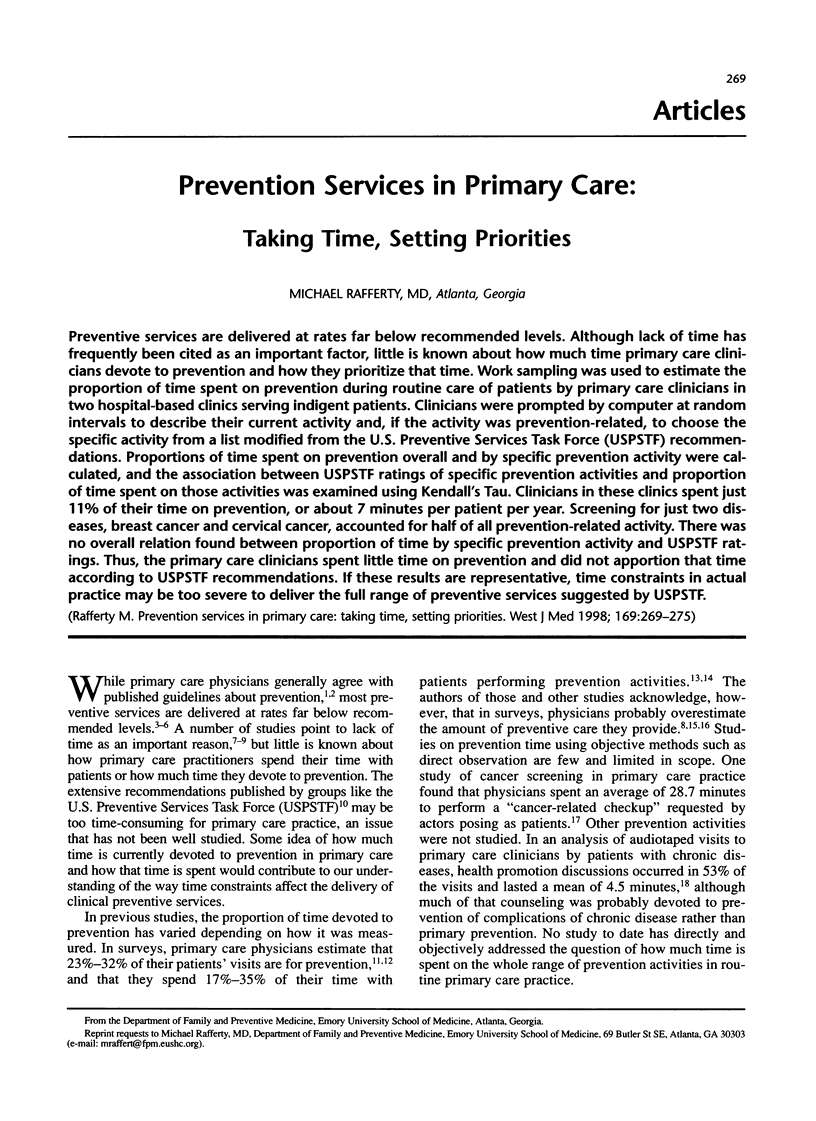
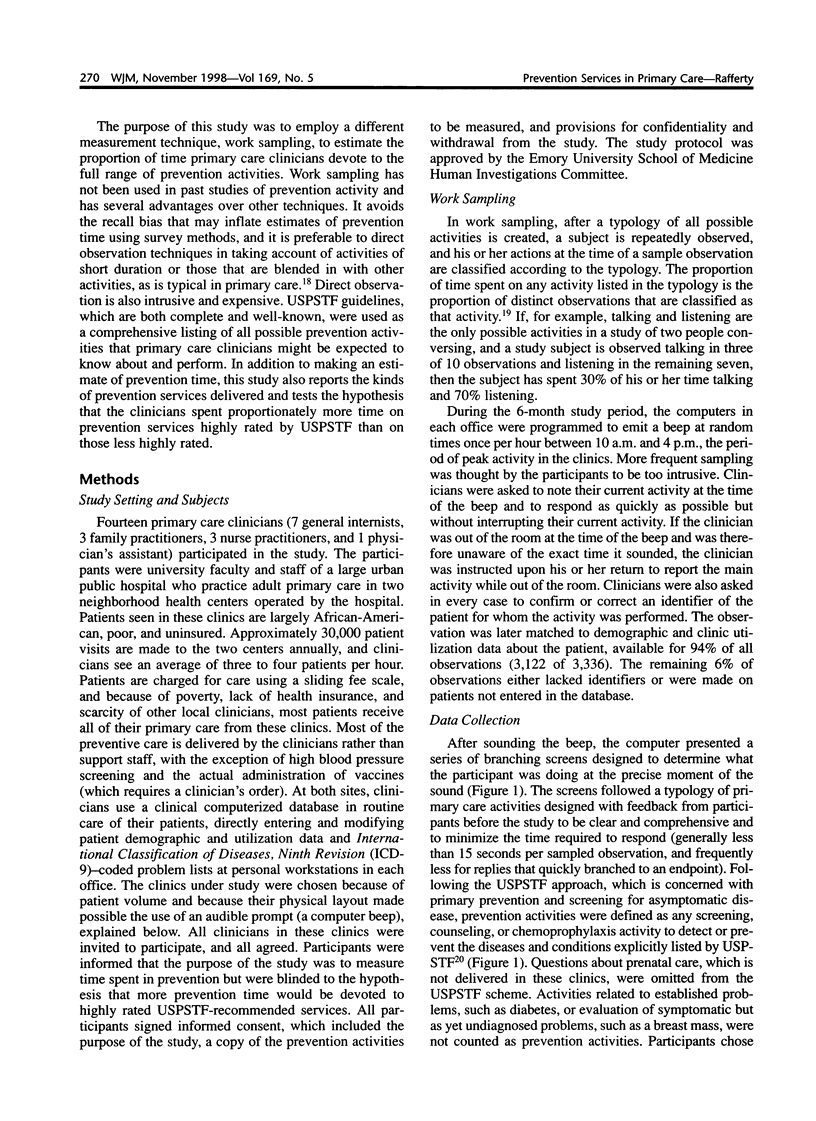
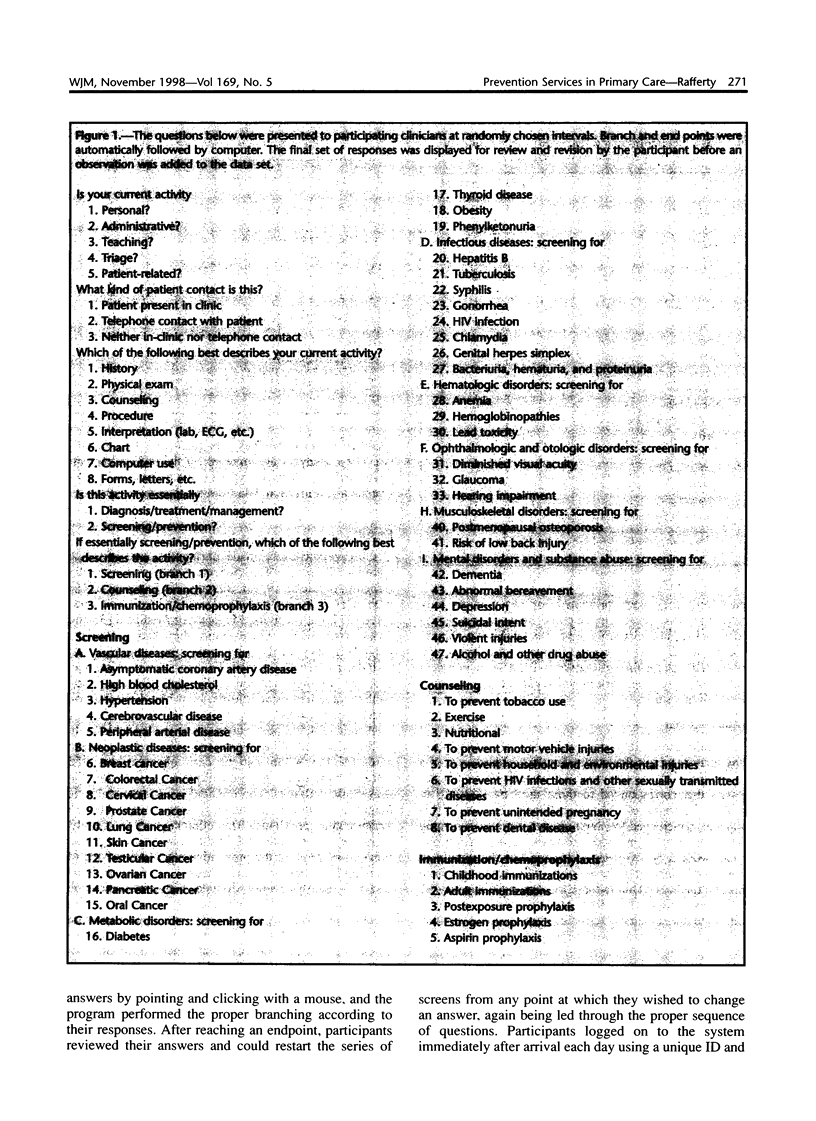
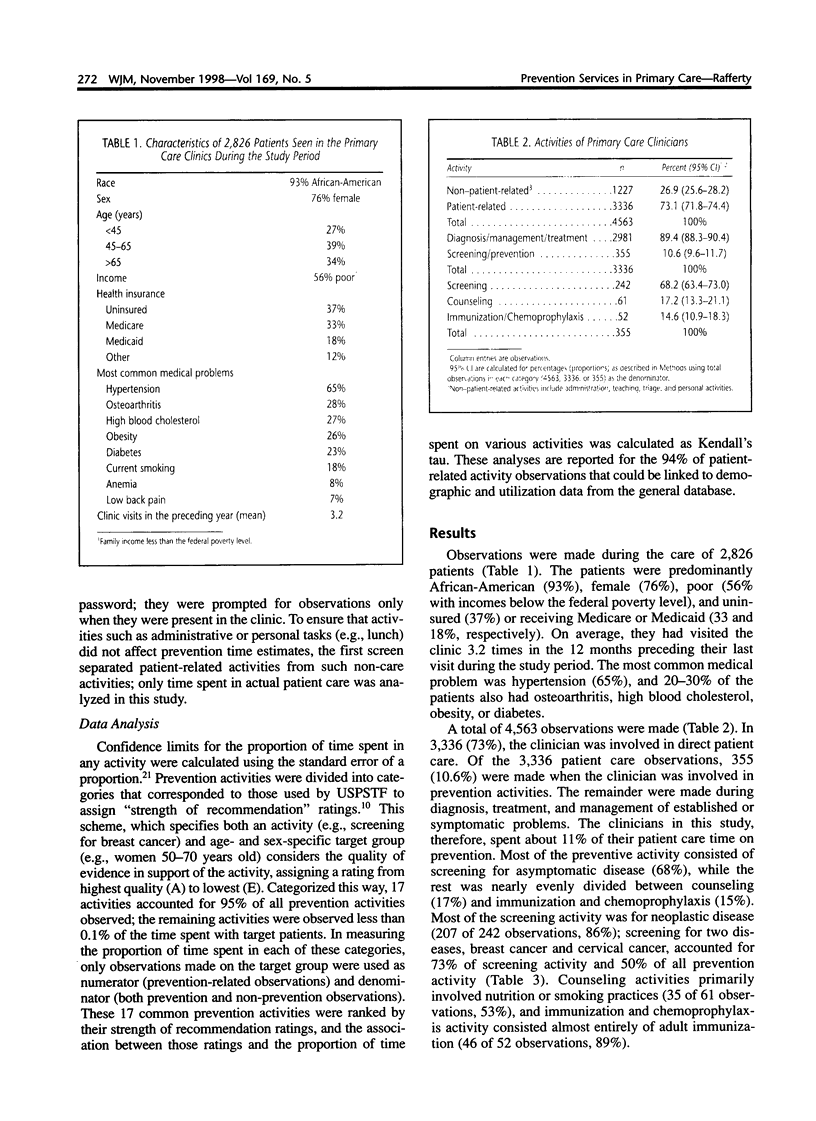
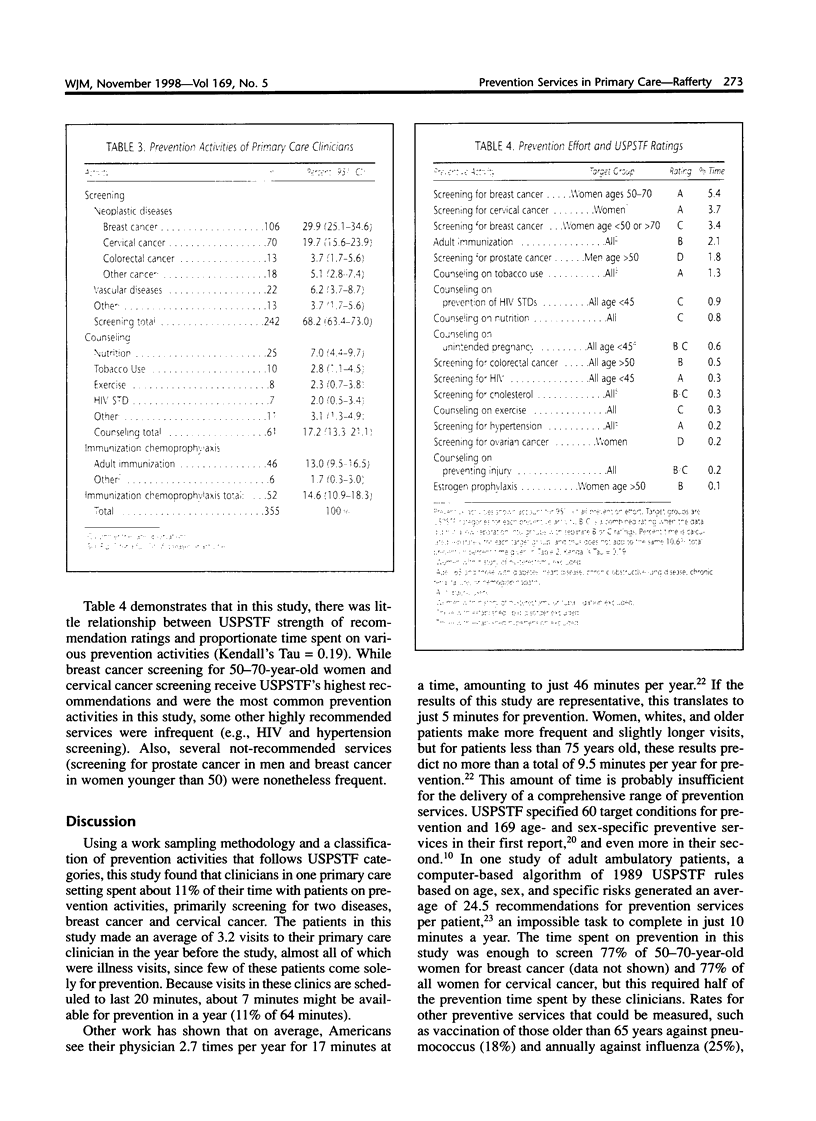
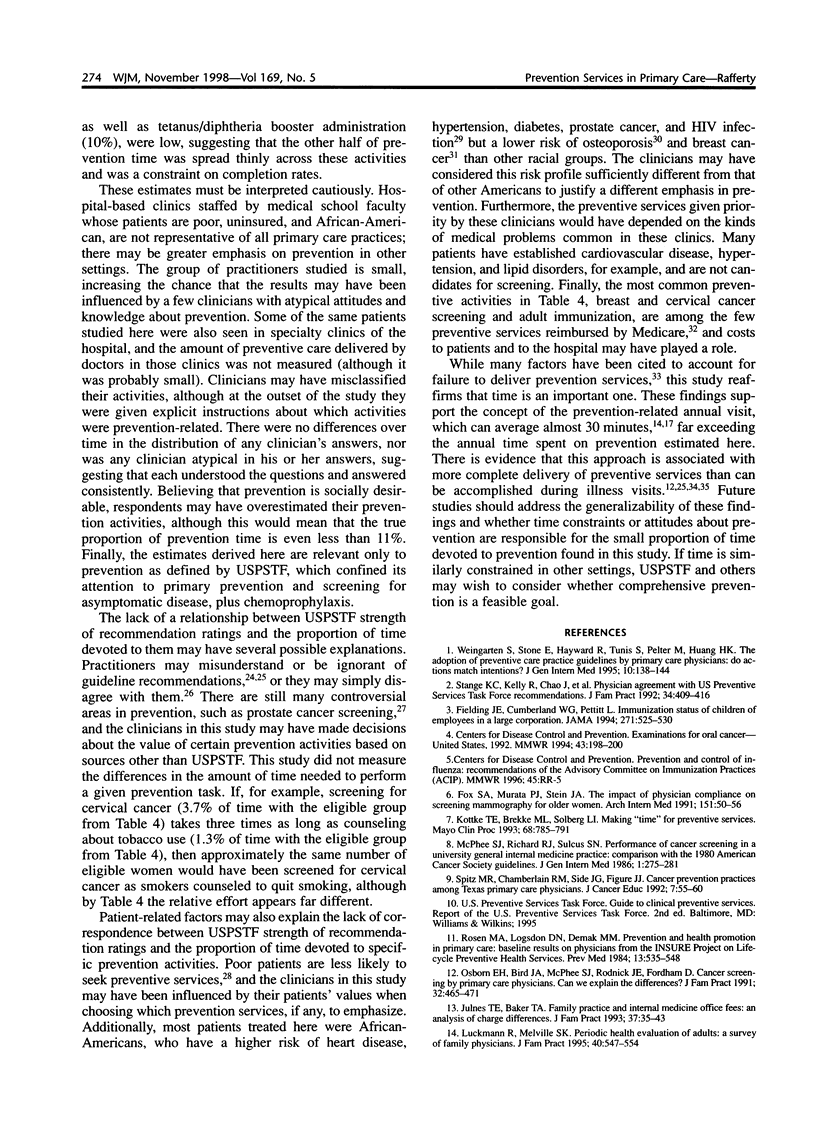
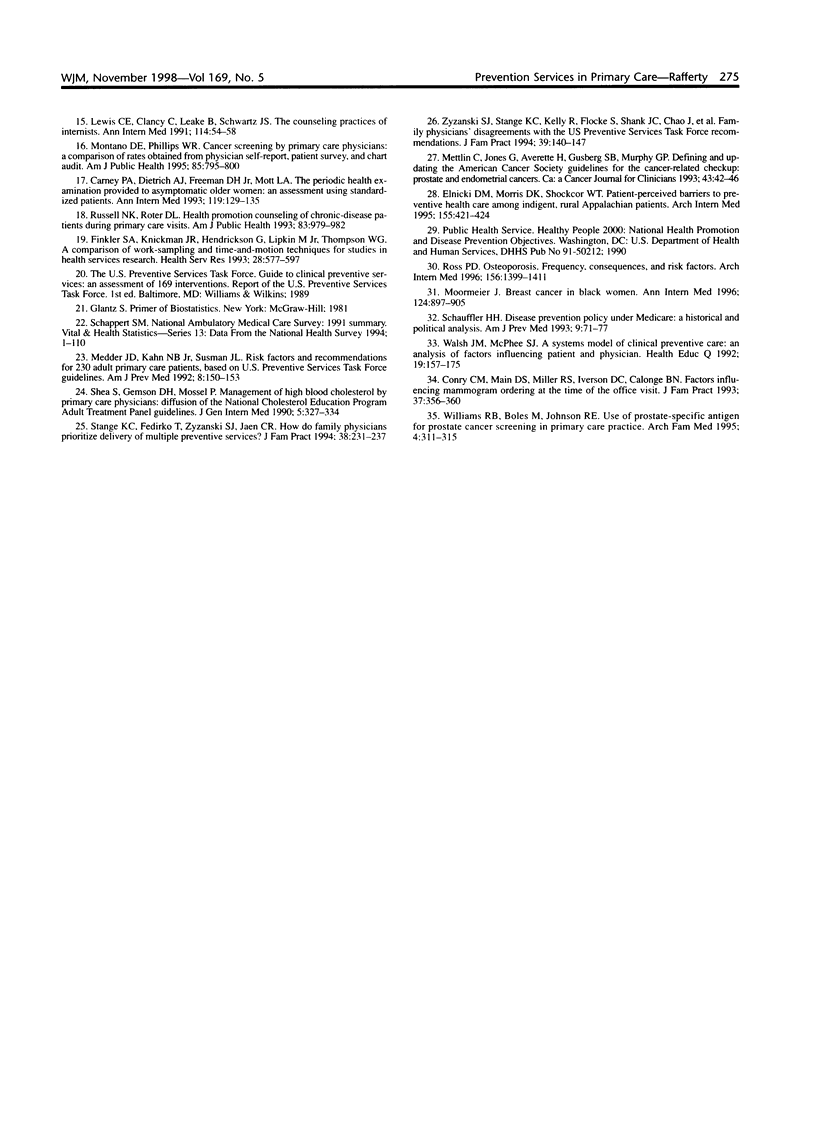
Selected References
These references are in PubMed. This may not be the complete list of references from this article.
- Carney P. A., Dietrich A. J., Freeman D. H., Jr, Mott L. A. The periodic health examination provided to asymptomatic older women: an assessment using standardized patients. Ann Intern Med. 1993 Jul 15;119(2):129–135. doi: 10.7326/0003-4819-119-2-199307150-00007. [DOI] [PubMed] [Google Scholar]
- Conry C. M., Main D. S., Miller R. S., Iverson D. C., Calonge B. N. Factors influencing mammogram ordering at the time of the office visit. J Fam Pract. 1993 Oct;37(4):356–360. [PubMed] [Google Scholar]
- Elnicki D. M., Morris D. K., Shockcor W. T. Patient-perceived barriers to preventive health care among indigent, rural Appalachian patients. Arch Intern Med. 1995 Feb 27;155(4):421–424. [PubMed] [Google Scholar]
- Fielding J. E., Cumberland W. G., Pettitt L. Immunization status of children of employees in a large corporation. JAMA. 1994 Feb 16;271(7):525–530. [PubMed] [Google Scholar]
- Finkler S. A., Knickman J. R., Hendrickson G., Lipkin M., Jr, Thompson W. G. A comparison of work-sampling and time-and-motion techniques for studies in health services research. Health Serv Res. 1993 Dec;28(5):577–597. [PMC free article] [PubMed] [Google Scholar]
- Fox S. A., Murata P. J., Stein J. A. The impact of physician compliance on screening mammography for older women. Arch Intern Med. 1991 Jan;151(1):50–56. [PubMed] [Google Scholar]
- Julnes T. E., Baker T. A. Family practice and internal medicine office fees: an analysis of charge differences. J Fam Pract. 1993 Jul;37(1):35–43. [PubMed] [Google Scholar]
- Kottke T. E., Brekke M. L., Solberg L. I. Making "time" for preventive services. Mayo Clin Proc. 1993 Aug;68(8):785–791. doi: 10.1016/s0025-6196(12)60638-7. [DOI] [PubMed] [Google Scholar]
- Lewis C. E., Clancy C., Leake B., Schwartz J. S. The counseling practices of internists. Ann Intern Med. 1991 Jan 1;114(1):54–58. doi: 10.7326/0003-4819-114-1-54. [DOI] [PubMed] [Google Scholar]
- Luckmann R., Melville S. K. Periodic health evaluation of adults: a survey of family physicians. J Fam Pract. 1995 Jun;40(6):547–554. [PubMed] [Google Scholar]
- McPhee S. J., Richard R. J., Solkowitz S. N. Performance of cancer screening in a university general internal medicine practice: comparison with the 1980 American Cancer Society Guidelines. J Gen Intern Med. 1986 Sep-Oct;1(5):275–281. doi: 10.1007/BF02596202. [DOI] [PubMed] [Google Scholar]
- Medder J. D., Kahn N. B., Jr, Susman J. L. Risk factors and recommendations for 230 adult primary care patients, based on U.S. Preventive Services Task Force guidelines. Am J Prev Med. 1992 May-Jun;8(3):150–153. [PubMed] [Google Scholar]
- Mettlin C., Jones G., Averette H., Gusberg S. B., Murphy G. P. Defining and updating the American Cancer Society guidelines for the cancer-related checkup: prostate and endometrial cancers. CA Cancer J Clin. 1993 Jan-Feb;43(1):42–46. doi: 10.3322/canjclin.43.1.42. [DOI] [PubMed] [Google Scholar]
- Montaño D. E., Phillips W. R. Cancer screening by primary care physicians: a comparison of rates obtained from physician self-report, patient survey, and chart audit. Am J Public Health. 1995 Jun;85(6):795–800. doi: 10.2105/ajph.85.6.795. [DOI] [PMC free article] [PubMed] [Google Scholar]
- Moormeier J. Breast cancer in black women. Ann Intern Med. 1996 May 15;124(10):897–905. doi: 10.7326/0003-4819-124-10-199605150-00007. [DOI] [PubMed] [Google Scholar]
- Osborn E. H., Bird J. A., McPhee S. J., Rodnick J. E., Fordham D. Cancer screening by primary care physicians. Can we explain the differences? J Fam Pract. 1991 May;32(5):465–471. [PubMed] [Google Scholar]
- Rosen M. A., Logsdon D. N., Demak M. M. Prevention and health promotion in primary care: baseline results on physicians from the INSURE Project on Lifecycle Preventive Health Services. Prev Med. 1984 Sep;13(5):535–548. doi: 10.1016/0091-7435(84)90022-7. [DOI] [PubMed] [Google Scholar]
- Ross P. D. Osteoporosis. Frequency, consequences, and risk factors. Arch Intern Med. 1996 Jul 8;156(13):1399–1411. doi: 10.1001/archinte.156.13.1399. [DOI] [PubMed] [Google Scholar]
- Russell N. K., Roter D. L. Health promotion counseling of chronic-disease patients during primary care visits. Am J Public Health. 1993 Jul;83(7):979–982. doi: 10.2105/ajph.83.7.979. [DOI] [PMC free article] [PubMed] [Google Scholar]
- Schappert S. M. National Ambulatory Medical Care Survey: 1991 summary. Vital Health Stat 13. 1994 May;(116):1–110. [PubMed] [Google Scholar]
- Schauffler H. H. Disease prevention policy under Medicare: a historical and political analysis. Am J Prev Med. 1993 Mar-Apr;9(2):71–77. [PubMed] [Google Scholar]
- Shea S., Gemson D. H., Mossel P. Management of high blood cholesterol by primary care physicians: diffusion of the National Cholesterol Education Program Adult Treatment Panel guidelines. J Gen Intern Med. 1990 Jul-Aug;5(4):327–334. doi: 10.1007/BF02600401. [DOI] [PubMed] [Google Scholar]
- Spitz M. R., Chamberlain R. M., Sider J. G., Fueger J. J. Cancer prevention practices among Texas primary care physicians. J Cancer Educ. 1992;7(1):55–60. doi: 10.1080/08858199209528142. [DOI] [PubMed] [Google Scholar]
- Stange K. C., Fedirko T., Zyzanski S. J., Jaén C. R. How do family physicians prioritize delivery of multiple preventive services? J Fam Pract. 1994 Mar;38(3):231–237. [PubMed] [Google Scholar]
- Stange K. C., Kelly R., Chao J., Zyzanski S. J., Shank J. C., Jaén C. R., Melnikow J., Flocke S. Physician agreement with US Preventive Services Task Force recommendations. J Fam Pract. 1992 Apr;34(4):409–416. [PubMed] [Google Scholar]
- Walsh J. M., McPhee S. J. A systems model of clinical preventive care: an analysis of factors influencing patient and physician. Health Educ Q. 1992 Summer;19(2):157–175. doi: 10.1177/109019819201900202. [DOI] [PubMed] [Google Scholar]
- Weingarten S., Stone E., Hayward R., Tunis S., Pelter M., Huang H., Kristopaitis R. The adoption of preventive care practice guidelines by primary care physicians: do actions match intentions? J Gen Intern Med. 1995 Mar;10(3):138–144. doi: 10.1007/BF02599668. [DOI] [PubMed] [Google Scholar]
- Williams R. B., Boles M., Johnson R. E. Use of prostate-specific antigen for prostate cancer screening in primary care practice. Arch Fam Med. 1995 Apr;4(4):311–315. doi: 10.1001/archfami.4.4.311. [DOI] [PubMed] [Google Scholar]
- Zyzanski S. J., Stange K. C., Kelly R., Flocke S., Shank J. C., Chao J., Jaén C. R., Smith C. K. Family physicians' disagreements with the US Preventive Services Task Force recommendations. J Fam Pract. 1994 Aug;39(2):140–147. [PubMed] [Google Scholar]


